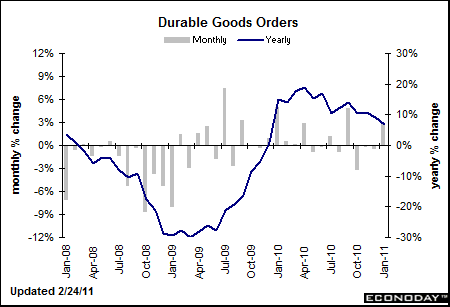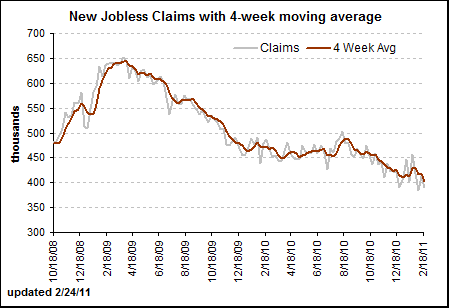There was quite a bit of economic date out this morning although investors appear to be largely ignoring the news in favor of the continued oil spike due to the events in the Middle East.
- Brent crude surged as high as $119 in overnight trade, but has since settled back down to $113. The surge sent equity futures tanking. Prices have settled down, however, remain 1%+ higher on the day. The situation is evolving quickly. In a research note this morning Goldman Sachs noted that there is “significant upside risk” to oil prices.
- Durable goods orders were fairly strong at 2.7% for January, but missed analyst expectations of 3%. When transportation is backed out orders declined -3.6%. The transportation component was almost entirely due to orders of non-military aircraft so the data is heavily skewed and weaker than the headline figure appears.

- Jobless claims continued to improve this week and point to mild job’s growth in the coming months. Econoday has the details on this morning’s report:
“Jobless claims data are indicating meaningful improvement for the labor market. Initial claims for the February 19 week fell 22,000 to 391,000 (prior week revised 3,000 higher to 413,000). The four-week average confirms the improvement, falling a sizable 16,500 to 402,000 for a nearly 30,000 decline from the month-ago level. A break below 400,000 in future weeks would begin to raise expectations for sizable payroll gains and extending declines for the unemployment rate. The Labor Department isn’t citing any special factors in the data though California was partially estimated in the week while three other states were fully estimated.
Continuing claims also fell substantially, down 145,000 in data for the February 12 week to 3.790 million. The four-week average is down 55,000 to 3.893 million for an 87,000 month-to-month improvement. The unemployment rate for insured workers fell one tenth to 3.0 percent. In other data, total unadjusted emergency claims, in data for the February 5 week, rose nearly 56,000 to 3.685 million. Total unadjusted unemployment claims fell nearly 90,000 to 9.159 million, also data for the February 5 week.”
- New home sales were up 284K for January. This was well below estimates of 310K. Supply jumped to 7.9 months. The housing market remains mired in a deep mess. Nothing new here.
All in all the data was pretty much consistent with what we have been seeing for several months now. Tepid job’s growth, terrible housing news and a generally fragile and lopsided recovery. Investors are focused primarily on the news in the Middle East which has the potential to severely disrupt consumer trends.
Mr. Roche is the Founder and Chief Investment Officer of Discipline Funds.Discipline Funds is a low fee financial advisory firm with a focus on helping people be more disciplined with their finances.
He is also the author of Pragmatic Capitalism: What Every Investor Needs to Understand About Money and Finance, Understanding the Modern Monetary System and Understanding Modern Portfolio Construction.


Comments are closed.